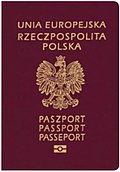| |
|---|---|
 | |
 The polycarbonate data page of the current Polish biometric passport | |
| Type | Passport |
| Issued by | Poland |
| First issued | 1918 (Second Polish Republic) 1929 (booklet) 1952 (Polish People's Republic) 1 January 1992 [1] (Third Polish Republic) 2001 (machine-readable passport) 1 January 2006 [2] (biometric version) 5 November 2018 (current version) |
| Purpose | Identification |
| Eligibility | Polish citizenship |
| Expiration | 5 years for children aged 0–13, 10 years for people aged 13+, 1 year for emergency travel documents |
| Cost | 140 PLN (adult under 70) 70 PLN (child above 12, adult with disabilities, students between 18 and 26 years old and few more groups) 35 PLN (students to 25, with valid Large Family Card) free (adults over 70) [3] 30 PLN (child under 12) 15 PLN (child under 12 with valid Large Family Card) [4] Temporary passport: 30 PLN [5] Second passport: 280 PLN [6] |
A Polish passport (Polish : Polski paszport) is an international travel document issued to nationals of Poland, and may also serve as proof of Polish citizenship. Besides enabling the bearer to travel internationally and serving as indication of Polish citizenship, the passport facilitates the process of securing assistance from Polish consular officials abroad or other European Union member states in case a Polish consular is absent, if needed.
Contents
- Issuance and validity
- Previous passport designs
- Second Polish Republic
- Polish People's Republic
- Third Polish Republic
- Physical appearance and data contained
- Biometric data
- Languages
- Visa free travel
- Gallery of Polish passports
- See also
- References and notes
- References
- Notes
Every Polish citizen is also a citizen of the European Union. The passport, along with the national identity card allows for free rights of movement and residence in any of the states of the European Union, European Economic Area and Switzerland.
According to the 2024 edition of the Henley Passport Index, the Polish passport allows visa-free travel to 189 countries and, together with the United States, Canada, the Czech Republic and Hungary, is ranked 6th globally in terms of travel freedom. [7]















